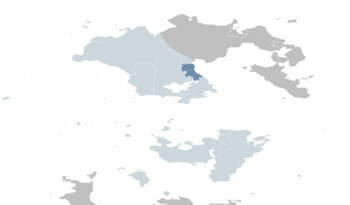Maregua: Difference between revisions
Jump to navigation
Jump to search
No edit summary |
No edit summary |
||
| Line 20: | Line 20: | ||
|symbol_type = Coat of Arms | |symbol_type = Coat of Arms | ||
|national_motto = {{unbulleted list|''[[Ñande Retãygua araka’eve ndofaltái]]''|{{small|''Our Countrymen are never in short supply''}}}} | |national_motto = {{unbulleted list|''[[Ñande Retãygua araka’eve ndofaltái]]''|{{small|''Our Countrymen are never in short supply''}}}} | ||
|national_anthem = "[[ | |national_anthem = "[[Tetã Abádeyvy Momorãhéi]]" <br>[[File:MediaPlayer.png|link=https://www.youtube.com/watch?v=17roe9HJis4|200px]] <br> | ||
|royal_anthem = | |royal_anthem = | ||
|royal_anthem = | |royal_anthem = | ||
Revision as of 09:31, 13 May 2023
This article is incomplete because it is pending further input from participants, or it is a work-in-progress by one author. Please comment on this article's talk page to share your input, comments and questions. Note: To contribute to this article, you may need to seek help from the author(s) of this page. |
Motto:
| |
| Anthem: "Tetã Abádeyvy Momorãhéi" | |
 Maregua Triania | |
| Capital | Naciente |
| Official languages | Avañe'e Lecirian Almagrian |
| Ethnic groups | See Ethnicity |
| Demonym(s) | Mareguan/s |
| Government | Unitary parliamentary semi-constitutional monarchy |
• King | Marangatu X |
• Prime Minister | Mba’evera Ygary |
| Legislature | National Assembly |
| Independence from Leciria | |
• Declared | 8 October 1756 |
| 28 April 1768 | |
| 17 June 1804 | |
| January-September 1820 | |
• Current Constitution | 2 May 1956 |
| Population | |
• 2019 estimate | |
• 2019 census | 41,392,293 |
• Density | 18.9/km2 (49.0/sq mi) |
| GDP (nominal) | estimate |
• Total | |
• Per capita | $15,594 |
| Date format | dd.mm.yyyy |
| Driving side | right |
| Calling code | +193 |
| ISO 3166 code | .MG |
Etymology
History
Prehistory
Geography
The Hullichi Region of northern Maregua and Atitlan.
The Caazapua Valley
Biodiversity
Climate
Politics and Government
King Marangatu X with the UN in 2019
Prime-Minister Mba’evera Ygary.
Foreign Relations
Military
Administrative Divisions
Law
Law Enforcement
Economy
Primary sector
Secondary sector
Tertiary sector
Quarternary sector
Energy
Natural resources
Demographics
Urbanization
Immigration
Religion
Languages
Education
Healthcare
Culture
See Also
References




